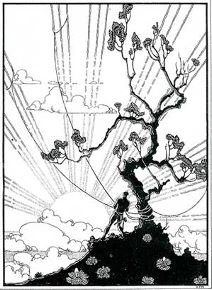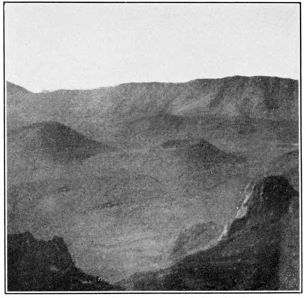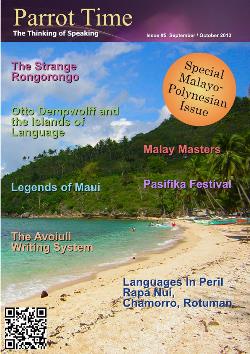Revisited
Legends of Maui - Maui Snaring the Sun

|
Before the battle with the sun occurred Maui went down into the underworld, according to the New Zealand tradition, and remained a long time with his relatives. In some way he learned that there was an enchanted jawbone in the possession of some one of his ancestors, so he waited and waited, hoping that at last he might discover it. After a time he noticed that presents of food were being sent away to some person whom he had not met.  Maui Snaring the Sun, pen and ink drawing by Arman Manookian, circa 1927, Honolulu Academy of Arts One day he asked the messengers, "Who is it you are taking that present of food to?" The people answered, "It is for Muri, your ancestress." Then he asked for the food, saying, "I will carry it to her myself." But he took the food away and hid it. "And this he did for many days," and the presents failed to reach the old woman. By and by she suspected mischief, for it did not seem as if her friends would neglect her so long a time, so she thought she would catch the tricky one and eat him. She depended upon her sense of smell to detect the one who had troubled her. As Sir George Grey tells the story: "When Maui came along the path carrying the present of food, the old chiefess sniffed and sniffed until she was sure that she smelt some one coming. She was very much exasperated, and her stomach began to distend itself that she might be ready to devour this one when he came near. Then she turned toward the south and sniffed and not a scent of anything reached her. Then she turned to the north, and to the east, but could not detect the odor of a human being. She made one more trial and turned toward the west. Ah! then came the scent of a man to her plainly and she called out, 'I know, from the smell wafted to me by the breeze, that somebody is close to me.'" Maui made known his presence and the old woman knew that he was a descendant of hers, and her stomach began immediately to shrink and contract itself again. Then she asked, "Art thou Maui?" He answered, "Even so," and told her that he wanted "the jaw-bone by which great enchantments could be wrought." Then Muri, the old chiefess, gave him the magic bone and he returned to his brothers, who were still living on the earth. Then Maui said: "Let us now catch the sun in a noose that we may compel him to move more slowly in order that mankind may have long days to labor in and procure subsistence for themselves." They replied, "No man can approach it on account of the fierceness of the heat." According to the Society Island legend, his mother advised him to have nothing to do with the sun, who was a divine living creature, "in form like a man, possessed of fearful energy," shaking his golden locks both morning and evening in the eyes of men. Many persons had tried to regulate the movements of the sun, but had failed completely. But Maui encouraged his mother and his brothers by asking them to remember his power to protect himself by the use of enchantments. The Hawaiian legend says that Maui himself gathered cocoanut fibre in great quantity and manufactured it into strong ropes. But the legends of other islands say that he had the aid of his brothers, and while working learned many useful lessons. While winding and twisting they discovered how to make square ropes and flat ropes as well as the ordinary round rope. In the Society Islands, it is said, Maui and his brothers made six strong ropes of great length. These he called aeiariki (royal nooses). The New Zealand legend says that when Maui and his brothers had finished making all the ropes required they took provisions and other things needed and journeyed toward the east to find the place where the sun should rise. Maui carried with him the magic jaw-bone which he had secured from Muri, his ancestress, in the under-world. They traveled all night and concealed themselves by day so that the sun should not see them and become too suspicious and watchful. In this way they journeyed, until "at length they had gone very far to the eastward and had come to the very edge of the place out of which the sun rises. There they set to work and built on each side a long, high wall of clay, with huts of boughs of trees at each end to hide themselves in." Here they laid a large noose made from their ropes and Maui concealed himself on one side of this place along which the sun must come, while his brothers hid on the other side. Maui seized his magic enchanted jaw-bone as the weapon with which to fight the sun, and ordered his brothers to pull hard on the noose and not to be frightened or moved to set the sun free. "At last the sun came rising up out of his place like a fire spreading far and wide over the mountains and forests.  Hale-a-ka-la Crater. Where the Sun Was Caught He rises up. His head passes through the noose. The ropes are pulled tight. Then the monster began to struggle and roll himself about, while the snare jerked backwards and forwards as he struggled. Ah! was not he held fast in the ropes of his enemies. Then forth rushed that bold hero Maui with his enchanted weapon. The sun screamed aloud and roared. Maui struck him fiercely with many blows. They held him for a long time. At last they let him go, and then weak from wounds the sun crept very slowly and feebly along his course." In this way the days were made longer so that men could perform their daily tasks and fruits and food plants could have time to grow. The legend of the Hervey group of islands says that Maui made six snares and placed them at intervals along the path over which the sun must pass. The sun in the form of a man climbed up from Avaiki (Hawaiki). Maui pulled the first noose, but it slipped down the rising sun until it caught and was pulled tight around his feet. Maui ran quickly to pull the ropes of the second snare, but that also slipped down, down, until it was tightened around the knees. Then Maui hastened to the third snare, while the sun was trying to rush along on his journey. The third snare caught around the hips. The fourth snare fastened itself around the waist. The fifth slipped under the arms, and yet the sun sped along as if but little inconvenienced by Maui's efforts. Then Maui caught the last noose and threw it around the neck of the sun, and fastened the rope to a spur of rock. The sun struggled until nearly strangled to death and then gave up, promising Maui that he would go as slowly as was desired. Maui left the snares fastened to the sun to keep him in constant fear. "These ropes may still be seen hanging from the sun at dawn and stretching into the skies when he descends into the ocean at night. By the assistance of these ropes he is gently let down into Ava-iki in the evening, and also raised up out of shadow-land in the morning." Another legend from the Society Islands is related by Mr. Gill: Maui tried many snares before he could catch the sun. The sun was the Hercules, or the Samson, of the heavens. He broke the strong cords of cocoanut fibre which Maui made and placed around the opening by which the sun climbed out from the under-world. Maui made stronger ropes, but still the sun broke them every one. Then Maui thought of his sister's hair, the sister Inaika, whom he cruelly treated in later years. Her hair was long and beautiful. He cut off some of it and made a strong rope. With this he lassoed or rather snared the sun, and caught him around the throat. The sun quickly promised to be more thoughtful of the needs of men and go at a more reasonable pace across the sky. A story from the American Indians is told in Hawaii's Young People, which is very similar to the Polynesian legends. An Indian boy became very angry with the sun for getting so warm and making his clothes shrink with the heat. He told his sister to make a snare. The girl took sinews from a large deer, but they shriveled under the heat. She took her own long hair and made snares, but they were burned in a moment. Then she tried the fibres of various plants and was successful. Her brother took the fibre cord and drew it through his lips. It stretched and became a strong red cord. He pulled and it became very long. He went to the place of sunrise, fixed his snare, and caught the sun. When the sun had been sufficiently punished, the animals of the earth studied the problem of setting the sun free. At last a mouse as large as a mountain ran and gnawed the red cord. It broke and the sun moved on, but the poor mouse had been burned and shriveled into the small mouse of the present day. A Samoan legend says that a woman living for a time with the sun bore a child who had the name "Child of the Sun." She wanted gifts for the child's marriage, so she took a long vine, climbed a tree, made the vine into a noose, lassoed the sun, and made him give her a basket of blessings. In Fiji, the natives tie the grasses growing on a hilltop over which they are passing, when traveling from place to place. They do this to make a snare to catch the sun if he should try to go down before they reach the end of their day's journey. This legend is a misty memory of some time when the Polynesian people were in contact with the short days of the extreme north or south. It is a very remarkable exposition of a fact of nature perpetuated many centuries in lands absolutely free from such natural phenomena. |
| Revisited - Maui Snaring the Sun | ||||
| Writer: | W. D. Westervelt | |||
| Images: | ||||
| ||||
| Sources: | ||||
| ||||
All images are Copyright - CC BY-SA (Creative Commons Share Alike) by their respective owners, except for Petey, which is Public Domain (PD) or unless otherwise noted.
comments powered by Disqus


















